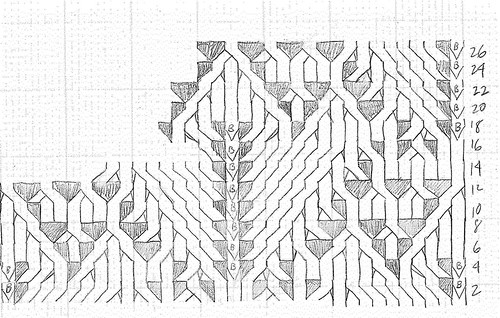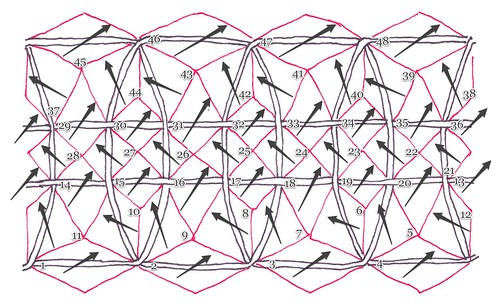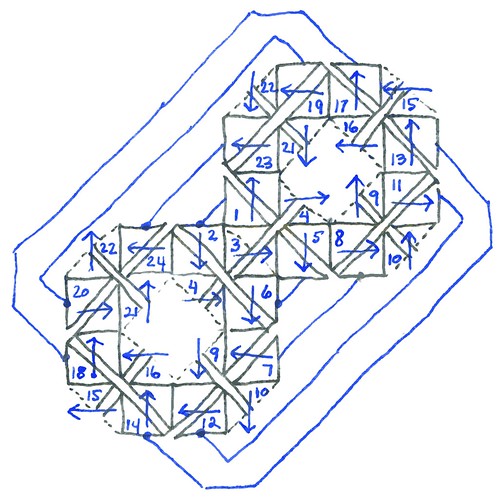Sometimes, the ambiguity of knitting terms bothers me.
The word "stitch," for example, means different things depending on context:
- A length of yarn being held on a needle.
- A minimal piece of knitted fabric.
I don't know why this particularly bothers me, but it did confuse me for a while when I was trying to figure out a way to model knitted fabrics using a computer program. (I still don't know how to do the data structure.)
Now, when I'm thinking of knitting, I'm more inclined to use "stitch" for only the second meaning, and to use "loop" for the first.
So, what is a stitch, in terms of loops?
A stitch is an interaction of loops. The simplest stitch-operation, a knit stitch, consumes a loop from a course previously worked. (A course is a row or round produced from a length of yarn.) A knit stitch supplies a loop to the course currently being worked.
What about yarnovers? A yarnover consumes no loops from the course previously worked, but contributes a loop to the current course, and, usually, to the next row or round of stitches. (It might be dropped, in which case it usually enlarges the stitches on either side of it.)
How does a knitted stitch differ from a purled stitch? It doesn't, without an observer. Both are single loops pulled through single loops. If I hold up a piece of stockinette fabric between us, what I call a knitted stitch will appear to you to be a purled stitch.
If I pulled the loop towards me while creating the stitch, I call it a knitted stitch. If I pushed the loop away from me while creating the stitch, I call it a purled stitch. Again, it's in reference to the observer, in this case, the knitter.
Here's another ambiguity: when I refer to a stitch, am I referring to structure or operation? Am I referring to how it appears, or how it was made?
So, what is a loop, in terms of stitches?
A loop is a length of yarn, fixed at its base, connected with running-threads to other loops in a course of yarn.
A loop participates in two rows of stitches (usually).
A row or round of stitches consumes loops from the course below and contributes loops to the course above.
A loop, in isolation, has no stability. It becomes part of a stable fabric when it's held together by subsequently formed loops, participating with these later loops in forming stitches. Loops that haven't fully become part of the fabric are held on needles, "stitch" holders, scrap yarn, etc., to keep them from unraveling until they can be used to create part of the knitted fabric.
A knitting needle doesn't hold stitches, it holds loops. The stitches that produced the held loops sit below the needle. That's the distinction of nomenclature I find useful. It makes a little more sense to me to say "2nd loop from the end of the left hand needle" rather than "2nd stitch".
Stitches and stitch-operations
A stitch is a minimal piece of knitted fabric. A stitch-operation is what you do to produce the stitch.
This yellow rectangle delimits what I mean by a stitch, as opposed to a loop:

Assuming that we're looking at a piece of knitted fabric that has been worked from the bottom up, the stitch within the rectangle could have been formed by any of these stitch-operations:
- Knit 1, from the left or from the right, done on the facing side.
- Purl 1, from the left or from the right, done on the back side.
This stitch consumed a loop from the red course, and provided a loop to the black course.
Look at the boundaries of the stitch. From the sides, the stitch is attached to other stitches with running-threads. From above and below, the stitch shares loops with the previously and subsequently worked rows.
In conclusion
I'm pondering the best way to be more precise about hand-knitting terms. I'm an INTP—I can't help it! I'm not there yet, but here are a few of my ideas so far.
- A stitch is the minimal unit, an atom, if you will, of knitted fabric.
- A stitch-operation is a method of forming a stitch.
- A stitch, by itself, gives no definitive clue to which stitch-operation formed it.
- Loops are units of a course (length) of yarn that have been pulled through other loops, or otherwise fixed on a holder.
- Courses are comprised of alternating loops and running-threads.
- Loops interacting with other loops produce stitches.
- Generally, a stitch is formed from more than one course of loops.
- A yarnover is a special case, since it is not formed with loops from a previous course of yarn. I think of it as an enlarged running-thread. It needs a needle or other holder to be created (between other loops in a course).
- When grafting two pieces of knitting together, you are actually forming two rows of stitches at the same time, using one course of yarn. For example, in grafting garter stitch, you're creating a row of knits and a row of purls.
Tell me what you think.
 maple leaf knitting pattern charted, originally uploaded by fuzzyjay.
maple leaf knitting pattern charted, originally uploaded by fuzzyjay.




